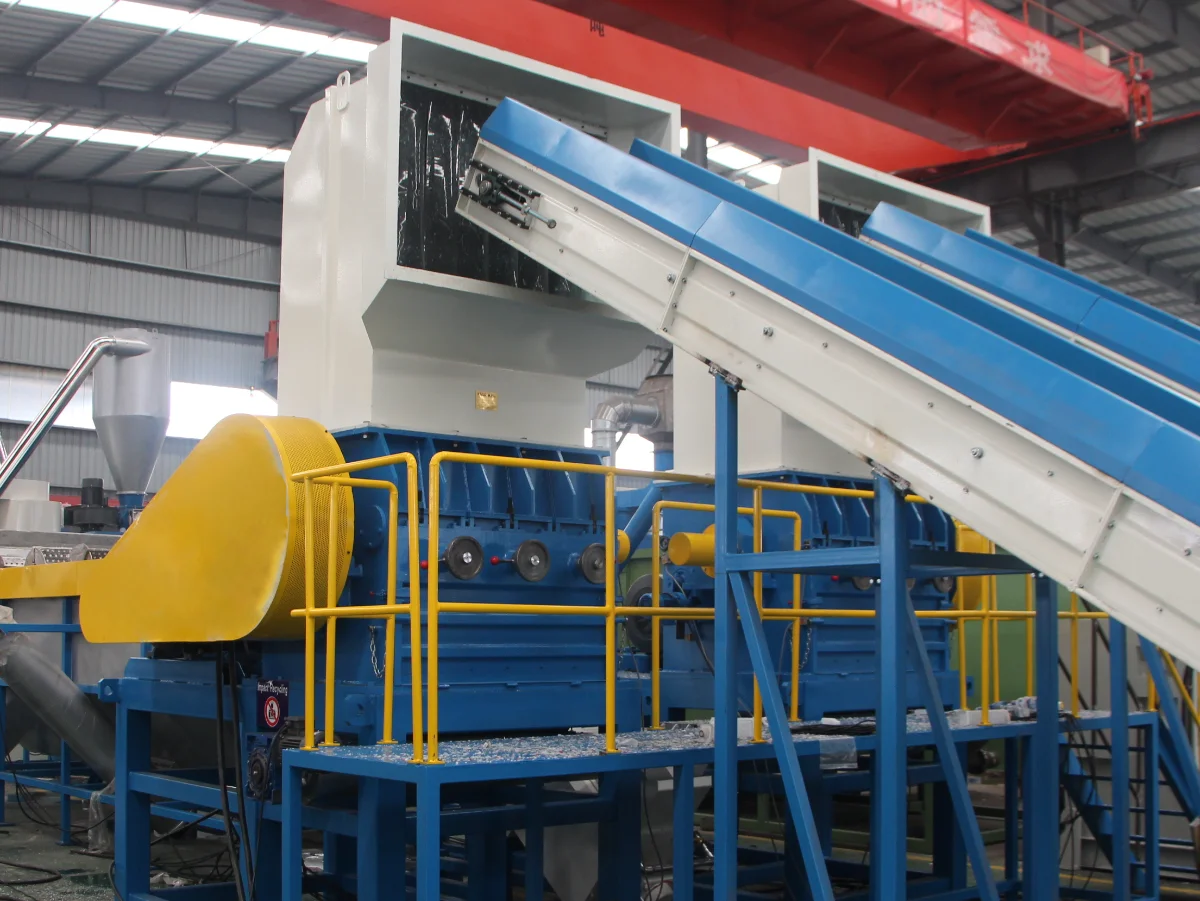Wet Plastic Grinding Machines: A Comprehensive Guide for Recycling Operations
Wet plastic grinding machines are a cornerstone of modern, efficient plastic recycling facilities. By introducing water directly into the size-reduction process, these machines do more than just granulate plastic; they simultaneously pre-wash materials, extend equipment life, and create a safer working environment. For recycling professionals and plant managers, understanding the mechanics, benefits, and applications of this technology is essential for optimizing throughput, improving recyclate quality, and boosting profitability.
This guide provides a detailed examination of wet plastic grinders, their operational principles, the critical differences between wet and dry grinding, and practical advice for selecting and maintaining the right equipment for your specific needs. We will explore how integrating a high-performance wet granulator can transform your recycling line.

What Exactly is a Wet Plastic Grinding Machine?
A wet plastic grinding machine, often called a wet granulator, is a piece of size-reduction equipment that uses a high-speed rotor with sharp knives to cut large plastic items into small, uniform flakes or regrind. Its defining feature is the continuous injection of water into the cutting chamber during operation.
This water serves multiple critical functions:
- Cooling: It actively cools the rotor, knives, and the plastic itself, preventing the material from melting due to friction. This is especially important for plastics with low melting points like LDPE film.
- Cleaning: The water flow acts as a powerful cleaning agent, washing away contaminants such as dirt, sand, paper labels, and food residue from the plastic surface.
- Lubrication: It lubricates the cutting action, reducing friction and wear on the blades.
- Dust Suppression: The water captures fine plastic particles and dust, preventing them from becoming airborne and creating a cleaner, safer atmosphere for operators.
The resulting output is a slurry of clean plastic flakes and contaminated water, which is then separated. The clean flakes can proceed to the next stage of the recycling process, like a friction washer or flotation tank, with a significant head start on cleanliness.
The Wet Grinding Process: A Step-by-Step Breakdown
Understanding the operational flow of a wet plastic grinder helps clarify its value within a larger recycling system. While designs vary between manufacturers, the core process remains consistent.
- Material Feeding: Pre-shredded or whole plastic items, such as PET bottles or HDPE jugs, are fed into the granulator’s hopper, typically via a conveyor belt.
- Water Injection: As the material enters the cutting chamber, a system of nozzles continuously sprays water onto the plastic and the cutting components. The water volume and pressure can often be adjusted based on the material type and contamination level.
- Size Reduction (Granulation): A heavy-duty rotor, spinning at high speeds (typically 400-600 RPM), forces the plastic against stationary bed knives. The shearing action of the rotor knives against the bed knives cuts the material into smaller pieces.
- Screening and Sizing: The cutting chamber is enclosed by a perforated screen. Material remains inside the chamber, continuously cut, until it is small enough to pass through the holes in the screen. The screen’s hole size determines the final flake dimension.
- Discharge: The mixture of correctly sized plastic flakes and water exits the machine through a discharge port at the bottom. This slurry is then transported, often by a screw conveyor or pump, to the next piece of equipment in the washing line.
Wet Grinding vs. Dry Grinding: A Direct Comparison
For any recycling operation, the choice between a wet and a dry granulator is a significant one. A dry granulator operates without water, relying on air suction to evacuate the material and control dust. Here is how they compare across key operational parameters:
| Feature | Wet Plastic Grinding Machine | Dry Plastic Grinding Machine |
|---|---|---|
| Cleaning Efficiency | High. Integrates a pre-washing step, effectively removing surface dirt, paper, and adhesives. | Low. Contaminants are granulated along with the plastic, requiring more intensive downstream washing. |
| Dust Control | Excellent. Water suppresses virtually all dust, improving air quality and workplace safety. | Requires a separate, energy-consuming air evacuation and filtration system to manage dust. |
| Blade Lifespan | Longer. Water cools and lubricates blades, reducing wear from heat and friction. Abrasive materials like sand are washed away, preventing premature dulling. | Shorter. Blades are subject to higher temperatures and increased friction, requiring more frequent sharpening or replacement. |
| Energy Consumption | Potentially lower overall system energy use, as it reduces the load on downstream washing equipment. | The granulator itself may use slightly less power, but the total system energy is higher due to the need for powerful dust collection systems. |
| Ideal Applications | Post-consumer plastics (PET bottles, HDPE containers), agricultural films, and other contaminated materials. | Clean, in-house industrial scrap (e.g., injection molding sprues, runners) where contamination is not an issue. |
| Maintenance | Requires management of the water system (filters, pumps). Less frequent blade maintenance. | Requires regular cleaning of dust collection filters. More frequent blade maintenance. |
Core Advantages of Integrating Wet Grinding into Your Workflow
Adopting wet plastic grinding machines offers tangible benefits that directly impact operational efficiency and the quality of the final product. The Association of Plastic Recyclers (APR) sets stringent guidelines for recyclate quality, and wet grinding helps meet these standards.
Superior Contaminant Removal
For post-consumer plastics, contamination is the primary challenge. Wet grinding tackles this head-on. The forceful, continuous water flow dislodges dirt, leftover liquids, and food residue. It also helps to separate paper and adhesive from labels, which is a critical step in producing high-purity PET flakes for bottle-to-bottle recycling.
Extended Blade and Machine Longevity
The operational costs of a granulator are heavily influenced by the maintenance schedule for its knives. By constantly cooling the cutting surfaces, a wet grinder prevents the blades from losing their temper and hardness due to excessive heat. This directly translates to longer intervals between sharpening and replacement, reducing downtime and spare parts costs. The lubrication effect also minimizes stress on bearings and the rotor assembly.
Enhanced Workplace Safety and Environmental Compliance
Plastic dust is a serious occupational hazard. It can be a respiratory irritant and, in high concentrations, combustible. As noted by the Occupational Safety and Health Administration (OSHA), managing combustible dust is a major safety priority. Wet grinding effectively eliminates airborne dust at the source, creating a much safer environment and simplifying compliance with air quality regulations.
Improved Quality and Value of Recycled Flakes
The ultimate goal of recycling is to produce a high-quality raw material. Cleaner flakes command a higher price on the market. By performing an aggressive pre-wash, wet grinders produce flakes that are significantly cleaner than those from a dry process. This reduces the burden on subsequent washing stages, allowing them to be more effective and resulting in a final product with lower contamination levels.
Key Applications and Suitable Plastic Materials
Wet plastic grinding machines are versatile, but they excel in specific applications where their cleaning capabilities provide the most value.
- PET Bottles: This is the primary application. Wet grinders efficiently remove paper labels, glue, and beverage residue, producing clean flakes ready for flotation tanks.
- HDPE Containers: Milk jugs, detergent bottles, and other HDPE containers are processed effectively. The water helps wash away product residue and dirt.
- Contaminated Plastic Films: Agricultural films (mulch films, greenhouse covers) are often heavily soiled. Wet grinding provides the initial, aggressive cleaning needed to make them recyclable.
- Mixed Rigid Plastics: Bales of mixed post-consumer plastics from curbside collection benefit greatly from the integrated washing process.
At Energycle Machine, we design our equipment to handle the toughest materials, ensuring reliable performance across a range of demanding applications.
Selecting the Right Wet Plastic Grinder for Your Needs
Choosing the correct machine requires a careful analysis of your specific operational requirements. Consider these factors:
- Throughput Capacity: How much material do you need to process per hour (kg/hr or lbs/hr)? Select a machine with a capacity that comfortably exceeds your current needs to allow for future growth.
- Input Material: What is the type, size, and contamination level of your plastic waste? Heavily contaminated or bulky materials may require a machine with a larger cutting chamber and a more robust rotor.
- Desired Flake Size: The final flake size is determined by the screen. Ensure the manufacturer can provide screens with the appropriate hole diameter for your target specification.
- Motor Power: The motor (measured in HP or kW) must be powerful enough to handle your toughest materials without stalling. Under-powered machines lead to low throughput and frequent jams.
- Construction and Durability: Look for machines built with heavy-duty, abrasion-resistant steel. The cutting chamber and rotor should be designed for easy access to facilitate knife changes and cleaning.
Maintenance and Operational Best Practices for Peak Performance
To maximize the lifespan and efficiency of your wet plastic grinder, a consistent maintenance schedule is non-negotiable.
- Daily Checks: Before starting, visually inspect the cutting chamber for any foreign objects (like metal) that could damage the knives. Check for water leaks.
- Blade Maintenance: Regularly inspect the knives for wear and damage. Rotate and sharpen them according to the manufacturer’s recommendations. Maintaining a precise knife gap is crucial for a clean, efficient cut.
- Screen Cleaning: Ensure the screen is free of blockages. Clogged screens reduce output and can cause material to overheat inside the chamber.
- Bearing Lubrication: Follow the recommended lubrication schedule for the rotor bearings to prevent premature failure. Listen for any unusual noises that could indicate a bearing issue.
- Water System Upkeep: Regularly check and clean the water inlet filters to ensure consistent flow and pressure. The quality of water used can impact both cleaning efficiency and machine wear.
By implementing these practices, you ensure your equipment operates at its best. Our team can provide tailored support and guidance on maintaining our advanced wet plastic granulators for long-term, trouble-free operation.
View Wet Plastic Granulator SpecificationsThe plastic recycling industry is continuously evolving to meet growing demands for high-quality recycled materials. According to the U.S. Environmental Protection Agency (EPA), the recycling rate for plastics remains a critical area for improvement, making efficient processing technology more important than ever. (Source: U.S. EPA). Wet plastic grinding machines are a direct answer to this challenge, offering a reliable and effective method to turn contaminated plastic waste into a valuable resource.



